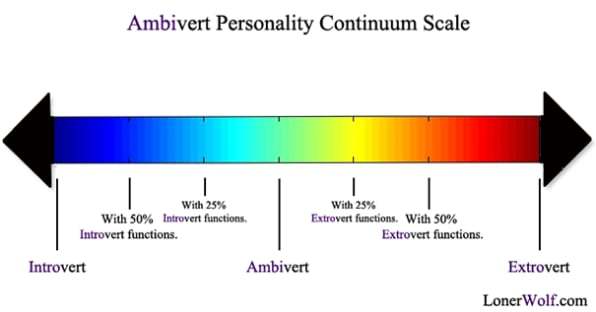‘Let’s head to the bars downtown. I heard there will be a massive party. It’s gonna be real fun!’ ‘Nah, I’ve got 300 pages to catch this weekend.’ ‘Come on, don’t be so discouraging. Two hours, okay?’ ‘Um.. I would rather-‘ ‘Are you really that shy? ‘I just prefer to be alone. It’s tiring outside.’ Typical introvert and extrovert traits, right? Introverts are shy and always want to be alone. Extroverts are outgoing. This is a major misconception of introverts and extroverts. Extroverts think that introverts never come out of their room; while in introverts’ mind, extroverts always stay way out of their room. This is a pure misunderstanding between the two. What if it is because they have to?
We’ve made it wrong – we’re all hybrids
The origins of the terms ‘introvert’ and ‘extrovert’ can be traced back to as early as 1920s, when a Swiss psychologist Carl Jung coined the two terms to contrast between two distinct personality types. In fact, introversion and extroversion are never two mutually exclusive qualities. More precisely, they are on the two opposite ends of a spectrum. Meanwhile, everyone of us falls on somewhere between the two extremes, only differing by the extent we are more introvert-like or extrovert-like. As Carl Jung put it,
▲ No one is a pure introvert or extrovert.
We have no choice. Our brains are the bosses.
Introverts and extroverts may behave very differently in people’s eyes. One may think it is just their preference to work like this. Yet, it is actually their brains that makes such a difference. They have no choice but to cope with it. How are their brains different?
Extroverts are hungry for stimuli, while introverts have much in store
Extroverts appear sociable and always try to be the centre of attention. This is in fact due to their comparatively weaker sensitivity to stimuli. That’s why they have to proactively seek outer stimuli in order to reach a functional equilibrium for their minds. Hans Eysenck, a German psychologist, defines extroverts by analyzing their baseline arousal. The result reveals extroverts have a lower baseline arousal. Consequently, they need to be engaged in more thrilling activities to gain satisfaction while introverts, with a higher baseline arousal, are more easily satisfied. By contrast, introverts are much more sensitive to stimuli. So they opt to escape from stimuli to avoid being overwhelmed. In fact, it is difficult for them to perform normally if they are constantly under the influence of stimuli. When it comes to recharging, introverts and extroverts seek entirely different ways as expected. Introverts gain energy by being alone while extroverts recharge themselves through social interaction.
Introverts take the long way, while extroverts take the shortcut
Ever wondered why extroverts think and make decisions much more quickly than introverts? First, it’s because the prefrontal cortex in the brains of introverts is much thicker than that of extroverts. Prefrontal cortex is an area responsible for deep thinking and planning. That’s why introverts are more fond of spending more time on rumination whenever they need to make decisions or come across some problems.
▲ Introverts’ brains are like a complex transport system, while extroverts’ brains are like a straightforward highway. Second, when it comes to processing information, introverts take a longer, more complicated pathway. The route passes along areas associated with memory, planning and problem-solving. By contrast, extroverts take a much shorter path. The shortcut mainly runs through areas responsible for sensory processing. Due to the different pathways they choose, extroverts tend to speak and act quickly, while introverts need more time to come up with a response.
Introverts and extroverts react differently to human faces
Aside from the structural difference of the brain, introverts and extroverts respond differently to human faces. When given a picture of human face and a picture of the wild nature, extroverts reach more vigorously to the human face one. Introverts, on the other hand, respond fairly the same to both pictures. Of course it doesn’t mean introverts don’t even feel a thing from any interaction. They just feel less strongly. They don’t feel as excited and require comparatively less social interaction to gain satisfaction. They still need social life.
Personality stereotypes are as terrible as gender stereotypes…
Stereotypes of introverts and extroverts are deep-rooted in everyone’s minds. Introverts are connected with ‘shy’ and ‘preference to be alone’ while extroverts are associated with ‘outgoing’ and ‘good at talking’. It is not true. Introverts in reality may even be a better public speaker for their deep and thorough thinking. Extroverts who have diverse interest in different topics are better at coping with small talk. Introverts do not prefer loneliness. They simply avoid being overwhelmed by stimuli due to their high sensitivity to stimuli. Hence, they are in favor of close conversation with a small group of people. By contrast, extroverts are in need of external stimuli so they prefer having fun with a large of people.
Can’t relate yourself to the two camps? Here’s the third one for you
Till now, we have been focusing on people on the two sides of the “introvert-extrovert” continuum. What about those in the middle? Ambiverts, that’s how we call them. Ask yourself these questions:
- Do you prefer time alone while also love people?
- Do certain situations make you feel outgoing while some reserved?
- Do you struggle with categorizing yourself as an introvert or extrovert? If your answer is yes to these questions. You are probably an ambivert. Ambiverts are those who possess traits from both introverts and extroverts. They exhibit qualities of both extremes in different situations. For example, you may be uncomfortable in a night club full of people but you feel energized being around your classmates at school. You feel awkward with a bunch of strangers while you are extroverted with your friends. Most people are actually ambiverts. Like the statement at the beginning, introvert and extrovert are just two extremes.
Find the common language. After all, we’re not from two different planets.
Introverts and extroverts don’t seem to go along with each other. Not true. Recognizing and accepting the difference between the two can create the best environment for co-existence.
Advice for introverts:
For introverts, you need to put your treasured ones slightly in front of your work. It may sound uncomfortable but the main point is to look for a comfortable balance between work and social life. Be aware not completely drop out of your social circle. Socializing with others is necessary. You understand you have limited energy to spare on so spend them wisely. Divide it equally for your work and social circle. Also, it is important to leave yourself some space to recharge. Never fully devote all the time on the others. Otherwise you will soon be exhausted mentally and physically. Give yourself at least a day per week to recharge. Striking for a balance is the main point.
Advice for extroverts:
Extrovert, on the other hand, you need to understand the difference. Don’t force introverts out of their comfort zone. Instead, find out when your introverted friends are okay to hang out. Forcing them out when they don’t want to only ends disastrously. None will be pleased in the end. You can communicate your schedule with them and look for the best possible plan to satisfy both sides. If, unfortunately, your friends are mostly introverted and you still feel dissatisfied after attempts to compromise, try to expand your social circles then. Join clubs, learn some new skills. Voluntary work would do the job too. Remember there is nothing bad to be either an introvert, extrovert or ambivert. The most important point is to understand yourself. Embrace who you are. Forcing yourself to become another person is a big no-no. Only by acknowledging and accepting the difference can we all live in a harmonious world. Featured photo credit: Personality Central via personality-central.com

